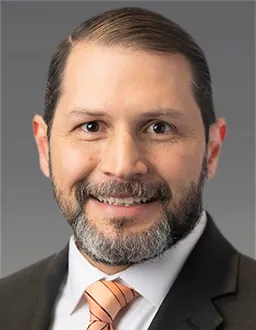Breadcrumb
- Home
- Conditions & Treatments
- Rhabdomyosarcoma
What is rhabdomyosarcoma?
Rhabdomyosarcoma is a cancerous tumor that grows in the body's soft tissues (which connect, support, or surround organs and other body structures), particularly in the muscles that attach to bone and help the body to move. Just weeks into the life of a developing embryo, rhabdomyoblast cells (which grow into muscle over time) begin to form. These are the cells that can develop into rhabdomyosarcoma. Because this is a cancer of embryonal cells, it is much more common in children, although it can occur in adults.
Symptoms & Causes
What are the symptoms of rhabdomyosarcoma?
Your child may not experience any symptoms of rhabdomyosarcoma until the tumor is very large, especially if it is located deep in the muscles or stomach. Common symptoms may include:
- A mass that can be seen or felt and may or may not be painful
- Bleeding from the nose, vagina, rectum, or throat (if the tumor is located in these areas)
- Tingling, numbness, or pain if the tumor compresses a nerve in the affected area
- Protrusion of the eye or drooping of the eyelid, which may indicate a tumor behind the eye
Keep in mind that some similar symptoms can be associated with more common medical problems and conditions. It is important to consult your child's physician for a diagnosis.
What causes rhabdomyosarcoma?
Rhabdomyosarcoma is not associated with environmental factors, and it is important to keep in mind that there is nothing that would have prevented the tumor from developing. Some rhabdomyosarcoma tumors are thought to begin developing in the fetus. Rhabdomyoblasts are the cells at the initial stages of development of an unborn baby. These cells will mature and develop into muscles. Rhabdomyosarcomas usually have some type of chromosome abnormality or genetic mutation in the cells of the tumor.
Diagnosis & Treatments
How is rhabdomyosarcoma diagnosed?
The first step in treating your child is forming an accurate and complete diagnosis. A physician may order a number of different tests to diagnose rhabdomyosarcoma. In addition to a medical history and physical exam, these may include:
- Blood and urine tests
- Computerized tomography (CT or CAT) scan
- Magnetic resonance imaging (MRI)
- X-ray
- Ultrasound
- Bone scans
- Bone marrow biopsy and/or aspiration
- Biopsy
- Lumbar puncture
What are the treatment options for rhabdomyosarcoma?
Treatment for rhabdomyosarcoma requires close coordination between surgeons, pediatric oncologists and radiotherapists. The response of tumors is very much dependent on their site of origin.
A series of studies have been performed by the Intergroup Rhabdomyosarcoma Study (IRS), now a part of the Children’s Oncology Group which has outlined the treatment of rhabdomyosarcoma. Dana-Farber/Boston Children’s plays an active role in this organization.
For treatment of rhabdomyosarcoma, surgery is often a first step — allowing doctors to form a complete diagnosis of the tumor type and providing information on the stage of the disease. Complete surgical removal of a rhabdomyosarcoma is often not possible. Your child's doctor may also recommend radiation therapy and/or chemotherapy. Radiation therapy can help stop the growth of abnormal cells in specific areas of the body using high-energy rays from a specialized machine to damage or kill abnormal cells.
Chemotherapy is systemic treatment, meaning it is introduced to the bloodstream and travels throughout the body to kill or slow the growth of targeted cells. Different groups of chemotherapy drugs work in different ways, and can be taken in a variety of ways including orally or intravenously. While chemotherapy can be quite effective in treating certain cancers, the agents don't completely differentiate normal healthy cells from abnormal cells. Because of this, your child could have adverse side effects during treatment.
Deciding on which of these approaches to use depends largely on the tumor's site. For instance, a sarcoma in the muscles of the arms or legs is often initially treated with surgical removal, which may be followed by chemotherapy with or without radiation. A tumor in the bladder or prostate requires chemotherapy prior to attempts at surgical removal or treatment with radiation. Tumors around the eye are very responsive to chemotherapy and radiation, so they rarely require surgical removal.
What is the long-term outlook for children with rhabdomyosarcoma?
The prognosis for children with rhabdomyosarcoma varies, but more than 70 percent survive five years after diagnosis if they have localized disease and receive combination therapy. After five years of disease-free survival, relapses are rare. Prompt medical attention for and aggressive therapy are critical for the best prognosis.
Your child's outcome will likely depend on a number of factors, including:
- The extent of the disease
- The size and location of the tumor
- The tumor's characteristics when examined under a microscope
- The presence or absence of metastasis
- The tumor's response to therapy
- The age and overall health of your child
- Uour child's tolerance of specific medications, procedures, or therapies
- New developments in treatment
How we care for rhabdomyosarcoma
Patients with rhabdomyosarcoma are treated at Dana-Farber/Boston Children's Cancer and Blood Disorders Center through our Bone and Soft Tissue Tumors Program. Because rhabdomyosarcoma can develop anywhere in a child’s body and will require surgery as part of treatment, it is important that your child be treated at a center that offers surgical expertise in the part of the body where your child’s tumor appears. At Dana-Farber/Boston Children’s we have urology, gynecology, head and neck, and general surgeons who have specialized expertise in treating these types of tumors in children.
Our center also offers a range of clinical trials for rhabdomyosarcoma, and we are New England's hub for the Children's Oncology Group — an international consortium of cancer treatment centers that conducts studies of pediatric cancers.
Research & Innovation
Our areas of research for rhabdomyosarcoma
Receiving care at Dana-Farber/Boston Children's means that your child will have access to therapies being tested by the nation's top researchers in pediatric cancer. We are the New England Phase I Center for the Children's Oncology Group, a group of cancer researchers from around the world dedicated to finding new treatments for pediatric cancer.
Our scientists are conducting numerous research studies to help doctors better understand and treat soft-tissue sarcomas. Treatments being evaluated include angiogenesis inhibitors, which are substances that might be able to prevent the growth of tumors; and biological therapies, which harness the body's immune system to fight cancer or lessen side effects.
For many children with rare or hard-to-treat conditions, clinical trials provide new options.





